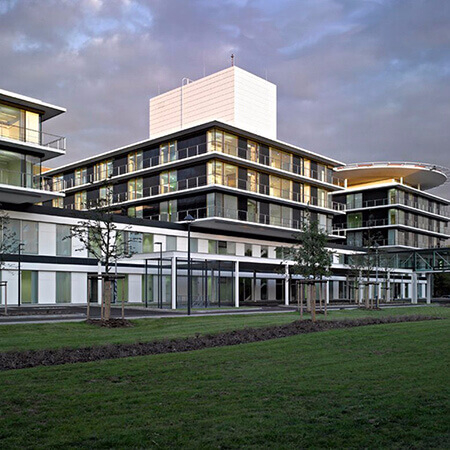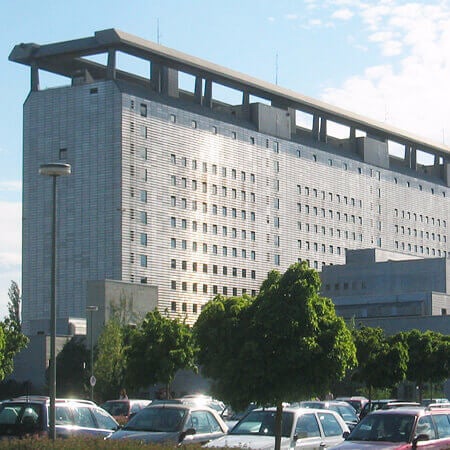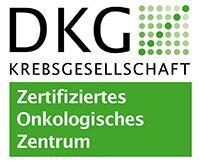Acute cholangitis is a rare but dangerous disease, an inflammatory process in the bile ducts. The condition primarily affects people aged 50-60 years. Cholangitis is diagnosed in 10% of patients hospitalized for cholelithiasis. Antibiotic therapy and endoscopic procedures are commonly used for bile duct inflammation treatment in Germany. Percutaneous procedures and surgery are used less frequently. Doctors in Germany perform surgery using laparoscopic techniques, so complications are rare, and the recovery time for the patients is significantly reduced.
Content
- Causes of bile duct inflammation
- Diagnostics
- Treatment
- Why is it better to undergo treatment in Germany?
- Cholangitis treatment in Germany
Causes of bile duct inflammation
Acute cholangitis is caused by an ascending bacterial infection of the bile ducts. Its leading cause is choledocholithiasis, the formation of stones in the bile ducts. In the presence of stones, the bile outflow into the intestine is disturbed, the blood supply to the tissues worsens, and they become infected as the inflammatory process progresses.
Bacteria cause cholangitis. Due to the complete obstruction of the duct, they multiply rapidly. Due to the increased pressure in the bile ducts, bacteria enter the bloodstream, provoking sepsis and infection of other internal organs.
Below are some other causes of cholangitis other than choledocholithiasis:
- pancreatic cancer;
- liver cancer;
- bile duct cancer;
- parasitic invasion;
- obstruction of a biliary stent (a tube that is placed in the bile duct to restore the bile outflow);
- Mirizzi syndrome is characterized by a stone stuck in the neck of the gallbladder or cystic duct, leading to the compression of the common bile or common hepatic duct;
- Lemmel syndrome, which is characterized by periampullary diverticulum (protrusion) of the duodenum;
- acquired immunodeficiency syndrome.
Common causative agents of cholangitis are the bacteria Escherichia coli, Klebsiella, Enterobacter, Pseudomonas and Citrobacter. They usually multiply due to the bile duct obstruction, but are sometimes also brought during medical procedures.
Diagnostics
Typically, patients see a doctor with symptoms such as fever, chills, malaise, abdominal pain, yellow skin, itchy skin, and discolored stools.
Abdominal ultrasound is usually the very first instrumental examination for Patients with complaints from the organs of the hepatobiliary system. The doctor can assess the condition of the liver and gallbladder with ducts and see their dilation and stones. The pancreas is also visualized because its diseases also cause cholangitis. The ultrasound scan can distinguish between intrahepatic and extrahepatic bile duct obstruction.
A liver and bile duct CT is a more accurate diagnostic test used to clarify the diagnosis. It allows doctors to identify concomitant diseases such as liver abscess, liver cancer, pancreatic cancer, and other diseases.
Magnetic resonance cholangiopancreatography is the most informative non-invasive diagnostic procedure. It can be performed without the slightest risk to health, which is the main advantage of MRI. For many patients, this is an opportunity to avoid endoscopic retrograde cholangiopancreatography. With the help of MRI, doctors can determine the cause of inflammation and the grade of the bile duct obstruction and detect choledocholithiasis, bile duct strictures, and dilation.
Endoscopic retrograde cholangiopancreatography is the most informative examination, which can also be performed for therapeutic purposes. Doctors insert instruments through the digestive tract into the bile and pancreatic ducts to assess their condition, perform a biopsy, remove stones, implant a stent, and perform other necessary diagnostic and therapeutic manipulations. This procedure is unsafe, but sometimes necessary. If you undergo treatment in a good hospital, then the health risks are minimal.
Treatment
The treatment of cholangitis aims at two goals:
- elimination of the bile duct obstruction;
- suppression of bacteria that caused inflammation.
Conservative therapy
Since bacteria causes bile duct inflammation, one of the essential steps in its treatment is to destroy them. The patients with cholangitis receive antibiotics. Preference is given to the drugs that can be highly concentrated in bile: fluoroquinolones, penicillins, carbapenems, and aminoglycosides. A person receives antibiotics intravenously from the first days after admission to the hospital. Then doctors switch to oral administration.
Hospitalization is required only for severe cholangitis. Outpatient basis can treat mild and moderate forms.
In severe cases, the patients may require hemodynamic support. They are administered intravenous crystalloid solutions, and when blood pressure drops, vasopressors are used.
Elimination of bile duct obstruction
Since the development of bacteria is caused by bile duct obstruction, doctors must eliminate it. Otherwise, cholangitis may recur even after successful antibiotic treatment.
When the patient has a severe condition, especially sepsis, the obstruction is removed immediately. In other situations, it is possible to suppress a bacterial infection. After the patient's health improves, an endoscopic procedure or surgery is performed to normalize the bile flow into the intestines.
Endoscopic papillosphincterotomy is the most common procedure to remove the bile duct obstruction. Doctors cut the major duodenal papilla so that stuck stones can pass into the intestine. The procedure is effective in more than 90% of patients with stones up to 1.5cm in size. The larger the stone, the more difficult it is to pass. The width of the ducts also affects the success of the procedure. Sometimes they are narrowed, so even small stones do not pass into the intestines. In such situations, their fragmentation and extraction in parts ARE required.
Balloon dilatation is the process of dilating the sphincter without cutting it. This is a more sparing and safe procedure, but its possibilities are limited. The technique is used only after the suppression of active bile duct inflammation. It is effective for single stones up to 1cm in size, without increased pressure in the bile ducts, while maintaining the function of the sphincter of Oddi.
Contact lithotripsy is the crushing of stones into fragments. The manipulation is performed during an endoscopic procedure or surgery. This is usually an addition to the papillosphincterotomy. There are different types of lithotripsy distinguished by the methods of performance applied. The procedure can be mechanical, laser, OR electrohydraulic.
Surgical treatment may be different depending on the underlying disease. This may be the removal of the gallbladder, the removal of stones from the bile duct, the removal of a tumor, cysts, or the formation of an anastomosis for the bile outflow from the bladder into the intestine. In Germany, most surgical interventions are performed using laparoscopic techniques. They are performed through short abdominal incisions, with long thin instruments, under the control of a tiny video camera.
Treatment of the underlying disease
The treatment of the underlying disease, which causes bile duct inflammation, usually begins after stabilizing the patient's health condition and eliminating acute cholangitis. The surgical interventions and procedures are scheduled, which makes them safer.
Cholelithiasis. The treatment method depends on the stones' number, size, location, and gallbladder function. The standard radical treatment method is gallbladder removal surgery (cholecystectomy), purifying the bile ducts from stones. If necessary, they are removed with forceps, pushed towards the intestines, crushed into fragments with a laser, and removed.
Malignant tumors. Resectable tumors require radical surgery for their removal. As a rule, this is a liver resection or a pancreatoduodenal resection (removal of the head of the pancreas and duodenum with the lymph nodes, gallbladder, part of the liver), depending on the type of cancer.
Some neoplasms cannot be removed. In such cases, doctors resort to local methods of control and systemic drug therapy. To suppress primary or Metastatic Liver Tumors, The Healthcare Professionals In Germany Use Chemoembolization And Ablation; While Some Hospitals Destroy The Tumors With The Use Of High-Intensity Focused Ultrasound. Radiation Therapy is often used to treat other types of cancer. Additionally, doctors perform the procedures to normalize the bile outflow: bile duct stenting, percutaneous drainage, and formation of a biliary-enteric anastomosis using laparoscopic surgery.
Parasitic invasion. The treatment begins with conservative therapy. Doctors use anthelmintics to kill parasites. They may then need to be physically removed to relieve the bile duct obstruction. An endoscopic papillosphincterotomy procedure can usually remove parasites, but if they enter the gallbladder, the patient requires gallbladder removal surgery.
Scar strictures. The main treatment methods are papillosphincterotomy and balloon dilatation. Some patients will need a bile duct stent placement. Stents have to be changed periodically, but modern drug-eluting devices used at the German hospitals can reduce the frequency of procedures. The stent is usually used as a temporary solution. If the patency of the bile ducts is not restored, then doctors perform a surgical intervention for biliary-enteric anastomosis.
Why is it better to undergo treatment in Germany?
If you live in a country with poorly developed medicine, you should opt for cholangitis treatment in Germany. In the countries with poorly developed healthcare systems:
- in 25% of cases, doctors underestimate the severity of the patient's condition, skipping sepsis;
- in severe cholangitis and the lack of timely medical care due to low-quality diagnostics, mortality rates reach 50%;
- mortality rate after surgery reaches 10%.
If you decide to undergo treatment in Germany, your health is in good hands. German specialists use high-precision diagnostic methods that provide comprehensive information about the function and structure of the hepatobiliary system. In 90% of cases, doctors successfully eliminate cholangitis with the help of medicines. Should the bile duct obstruction be eliminated, preference is given to minimally invasive endoscopic techniques. In the specialized centers, they are performed by doctors who perform hundreds of such procedures every year, which ensures efficiency up to 98% with minimal risk of complications.
With the surgical treatment required, doctors perform operations using a laparoscopic approach. They are safer for health than conventional operations through a large abdominal incision.
Cholangitis treatment in Germany
If you are going to have treatment for bile duct inflammation in one of the German hospitals, the Booking Health service will be helpful. On our website you can get up-to-date and accurate information about the cost of treatment in Germany, compare prices in different German hospitals and book a medical care program at the best price. The treatment in Germany will be easier and faster for you, and the cost of treatment in Germany will be lower.
Please leave your request on the website of the international medical tourism agency Booking Health. Our employee will contact you, provide any information you need and answer all your questions. We will take care of the organization of your trip. We will provide the following benefits for you:
- We will select a German hospital whose doctors specialize in cholangitis treatment and achieve the best results.
- We will help to overcome the language barrier and establish communication with the doctor of the German hospital.
- The waiting period for treatment in Germany will be reduced for you, and you will receive medical care on the most suitable dates.
- We will reduce the price. The cost of treatment in Germany will be lower than usual. It will be lower due to the elimination of overpricing and additional coefficients for foreign patients.
- Our specialists will solve any organizational issues: paperwork, transfer from the airport to the German hospital and back, hotel booking, interpreting services.
- We will prepare your documents and translate them into English or German. The doctor will receive the necessary information about your health condition and you will not have to repeat the previously performed diagnostic procedures.
- We will keep in touch with the German hospital after the completion of treatment in Germany.
- We will organize additional treatment in Germany, diagnostics or rehabilitation, if required.
- We will buy medicines in Germany and forward them to your country.
While the best specialists in the world are taking care of your health, the Booking Health staff will help to reduce the cost of treatment in Germany and take care of all the travel arrangements.
Authors:
This article was edited by medical experts, board-certified doctors Dr. Nadezhda Ivanisova, and Dr. Bohdan Mykhalniuk. For the treatment of the conditions referred to in the article, you must consult a doctor; the information in the article is not intended for self-medication!
Our editorial policy, which details our commitment to accuracy and transparency, is available here. Click this link to review our policies.
Sources:
MedicineNet
Centers for Disease Control and Prevention
Johns Hopkins Medicine



















